Project Log: Saturday, September 8, 2012
I continued with various wiring tasks in and around the
underside of the dash, looking to mostly complete the
wire runs there before moving on.
With several new cables on hand for the SimNet network,
I completed those connections as needed, securing
network cables for the AIS, NSE-8 monitor, and stringing
a longer cable through the console and towards the aft
part of the boat, where, along with an Ethernet cable
I'd started down the journey earlier, I'd eventually
connect it to the radar control box. |
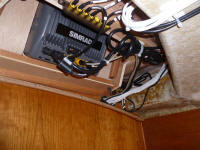
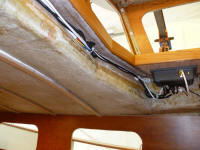 |
Meanwhile, I strung a few final lengths of duplex safety
wire, running them forward to the mast area to
accommodate mast lighting, and also made up a length of
coax cable, which I connected to the VHF and ran forward
as well. To lead these forward beneath the
eventual overhead, I cut out short sections of the
support cleats in way of the wire runs, then secured the
wires along the way.
I included the cable connecting the autopilot's rate
compass, which I planned to mount in the tall locker
forward of the galley. I might have preferred to
mount it elsewhere, but with cast iron ballast running
the length of the bilge, and of course the engine in the
after part of the boat--coupled with a 2 meter ideal
minimum distance from magnetic interference, the locker
seemed the best (only) choice. For now, I left the
unit loose pending final mounting and final disposition
of the interior of the locker itself.
The shorter wire hanging from the overhead is slated for
a possible overhead lighting circuit. |
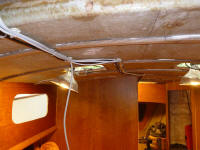
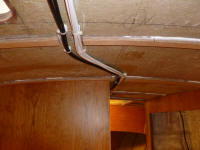
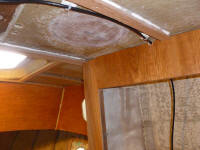
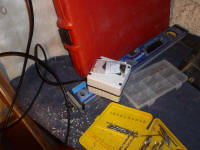 |
After hours of fruitless and increasingly frustrating
research over the course of the week, I concluded that
unfortunately, there was no direct way to adapt my 7 pin
blue Lowrance depthsounder connector directly to my
network: no such adapters existed, a fact I'd
determined individually before coming across
this post that more or less cemented the idea with
finality for me. An adapter I'd purchased earlier,
hoping it would be the right one, turned out to be
completely different from what I needed, so I returned
it.
I probably could have looked into a wire-to-wire
adaptation by cutting the end of my transducer cable,
but this was not something I wanted to do, preferring to
maintain the original integrity of the cable as
designed. I do not like dealing with pinouts
and fussy little wires. Replacing the transducer
that I'd installed in an intentionally and essentially
permanent way was not a realistic option either.
I'd never thought to look into the network connections
before installing the transducer since I made the
obviously wrong assumption that the transducer
advertised as being compatible with my Simrad products
actually would be. In fairness, it was: just
not without an additional product purchase.
Weary of the frustration and needing to move on, I
purchased the BSM-1 sounder module, which was designed
for my connector and which I could easily connect to the
network. I didn't need fishfinder capabilities,
but I wanted an overall system that worked perfectly,
without compromise, and felt there was no other viable
way to accomplish that. What the boat wants, the
boat gets. |
| |
Total Time Today: 3 hours
|
<
Previous | Next > |
|
|







